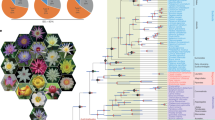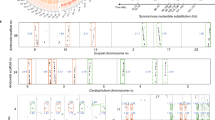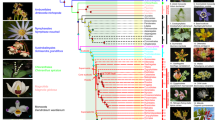Abstract
Although the relationship of angiosperms to other seed plants remains controversial1, great progress has been made in identifying the earliest extant splits in flowering-plant phylogeny, with the discovery that the New Caledonian shrub Amborella trichopoda, the water lilies (Nymphaeales), and the woody Austrobaileyales constitute a basal grade of lines that diverged before the main radiation in the clade2,3,4,5,6,7,8. By focusing attention on these ancient lines, this finding has re-written our understanding of angiosperm structural and reproductive biology, physiology, ecology and taxonomy9,10,11,12. The discovery of a new basal lineage would lead to further re-evaluation of the initial angiosperm radiation, but would also be unexpected, as nearly all of the ∼460 flowering-plant families have been surveyed in molecular studies10. Here we show that Hydatellaceae, a small family of dwarf aquatics that were formerly interpreted as monocots, are instead a highly modified and previously unrecognized ancient lineage of angiosperms. Molecular phylogenetic analyses of multiple plastid genes and associated noncoding regions from the two genera of Hydatellaceae identify this overlooked family as the sister group of Nymphaeales. This surprising result is further corroborated by evidence from the nuclear gene phytochrome C (PHYC), and by numerous morphological characters. This indicates that water lilies are part of a larger lineage that evolved more extreme and diverse modifications for life in an aquatic habitat than previously recognized.
This is a preview of subscription content, access via your institution
Access options
Subscribe to this journal
Receive 51 print issues and online access
$199.00 per year
only $3.90 per issue
Buy this article
- Purchase on Springer Link
- Instant access to full article PDF
Prices may be subject to local taxes which are calculated during checkout




Similar content being viewed by others
References
Burleigh, J. G. & Mathews, S. Phylogenetic signal in nucleotide data from seed plants: implications for resolving the seed plant tree of life. Am. J. Bot. 91, 1599–1613 (2004)
Soltis, P. S., Soltis, D. E. & Chase, M. W. Angiosperm phylogeny inferred from multiple genes as a tool for comparative biology. Nature 402, 402–404 (1999)
Graham, S. W. & Olmstead, R. G. Utility of 17 chloroplast genes for inferring the phylogeny of the basal angiosperms. Am. J. Bot. 87, 1712–1730 (2000)
Mathews, S. & Donoghue, M. J. Basal angiosperm phylogeny inferred from duplicate phytochromes A and C. Int. J. Plant Sci. 161, (6 Suppl.)S41–S55 (2000)
Zanis, M. J., Soltis, D. E., Soltis, P. S., Mathews, S. & Donoghue, M. J. The root of angiosperms revisited. Proc. Natl Acad. Sci. USA 99, 6848–6853 (2002)
Borsch, T. et al. Noncoding plastid trnT–trnF sequences reveal a well resolved phylogeny of basal angiosperms. J. Evol. Biol. 16, 558–576 (2003)
Qiu, Y.-L. et al. Phylogenetic analyses of basal angiosperms based on nine plastid, mitochondrial, and nuclear genes. Int. J. Plant Sci. 166, 815–842 (2005)
Leebens-Mack, J. et al. Identifying the basal angiosperm node in chloroplast genome phylogenies: sampling one’s way out of the Felsenstein zone. Mol. Biol. Evol. 22, 1948–1963 (2005)
Doyle, J. A. & Endress, P. K. Morphological phylogenetic analysis of basal angiosperms: comparison and combination with molecular data. Int. J. Plant Sci. 161, (6 Suppl.)S121–S153 (2000)
Angiosperm Phylogeny Group (APG II). An update of the Angiosperm Phylogeny Group classification for the orders and families of flowering plants. Bot. J. Linn. Soc. 141, 399–436 (2003)
Williams, J. H. & Friedman, W. E. The four-celled female gametophyte of Illicium (Illiciaceae; Austrobaileyales): implications for understanding the origin and early evolution of monocots, eumagnoliids, and eudicots. Am. J. Bot. 91, 332–351 (2004)
Feild, T. S., Arens, N. C., Doyle, J. A., Dawson, T. E. & Donoghue, M. J. Dark and disturbed: a new image of early angiosperm ecology. Paleobiology 30, 82–107 (2004)
Hamann, U. Hydatellaceae—a new family of Monocotyledoneae. N. Zeal. J. Bot. 14, 193–196 (1976)
Bremer, K. Gondwanan evolution of the grass alliance of families (Poales). Evolution 56, 1374–1387 (2002)
Dahlgren, R. M. T., Clifford, H. T. & Yeo, P. F. The Families of the Monocotyledons: Structure, Evolution, and Taxonomy (Springer, Berlin, 1985)
Hamann, U. in The Families and Genera of Vascular Plants IV. Flowering Plants. Monocotyledons. Alismatanae and Commelinanae (except Gramineae) (ed. Kubitzki, K.) 231–234 (Springer, Berlin, 1998)
Stevenson, D. W. et al. in Monocots: Systematics and Evolution (eds Wilson, K. L. & Morrison, D. A.) 17–24 (CSIRO, Collingwood, Australia, 2000)
Michelangeli, F. A., Davis, J. I. & Stevenson, D. W. Phylogenetic relationships among Poaceae and related families as inferred from morphology, inversions in the plastid genome, and sequence data from the mitochondrial and plastid genomes. Am. J. Bot. 90, 93–106 (2003)
Graham, S. W., Olmstead, R. G. & Barrett, S. C. H. Rooting phylogenetic trees with distant outgroups: a case study from the commelinoid monocots. Mol. Biol. Evol. 19, 1769–1781 (2002)
Doyle, J. A. Early evolution of angiosperm pollen as inferred from molecular and morphological phylogenetic analyses. Grana 44, 227–251 (2005)
Sun, G. et al. Archaefructaceae, a new basal angiosperm family. Science 296, 899–904 (2002)
Graham, S. W. et al. in Monocots: Comparative Biology and Evolution (excluding Poales) (eds Columbus, J. T., Friar, E. A., Porter, J. M., Prince, L. M. & Simpson, M. G.) 3–21 (Rancho Santa Ana Botanic Garden, Claremont, California, 2006)
Chase, M. W. et al. in Monocots: Comparative Biology and Evolution (excluding Poales) (eds Columbus, J. T., Friar, E. A., Porter, J. M., Prince, L. M. & Simpson, M. G.) 63–75 (Rancho Santa Ana Botanic Garden, Claremont, California, 2006)
Swofford, D. L. Phylogenetic Analysis Using Parsimony* (PAUP*) (Sinauer Associates, Sunderland, Massachusetts, 2002)
Guindon, S. & Gascuel, O. A simple, fast, and accurate algorithm to estimate large phylogenies by maximum likelihood. Syst. Biol. 52, 696–704 (2003)
Hamann, U. Neue Untersuchungen zur Embryologie und Systematik der Centrolepidaceae. Bot. Jahrb. Syst. 96, 154–191 (1975)
Cooke, D. A. in The Families and Genera of Vascular Plants IV. Flowering Plants. Monocotyledons. Alismatanae and Commelinanae (except Gramineae) (ed. Kubitzki, K.) 106–109 (Springer-Verlag, Berlin, 1998)
Appel, O. & Bayer, C. in The Families and Genera of Vascular Plants IV. Flowering Plants. Monocotyledons. Alismatanae and Commelinanae (except Gramineae) (ed. Kubitzki, K.) 208–211 (Springer, Berlin, 1998)
Kim, S., Soltis, D. E., Soltis, P. S., Zanis, M. J. & Suh, Y. Phylogenetic relationships among early-diverging eudicots based on four genes: were the eudicots ancestrally woody? Mol. Phylog. Evol. 31, 16–30 (2004)
Maddison, D. R. & Maddison, W. P. MacClade 4: Analysis of Phylogeny and Character Evolution, Version 4.03 (Sinauer Associates, Sunderland, Massachusetts, 2001)
Harden, G. J. (ed.) Flora of New South Wales. Vol. 4 (Univ. of New South Wales, Kensington, New South Wales, Australia, 1993)
Acknowledgements
We are grateful to K. Bremer (Uppsala University) and the Royal Botanic Gardens, Kew, for generously providing DNAs, and to J. Conran, J. Davis, A. Doust, P. Rudall and D. Stevenson and other workers responsible for making the field collections and generating cultivated material. We acknowledge critical review of the manuscript by S. C. H. Barrett, M. W. Chase, T. S. Feild and E. M. Friis. This research was supported by an NSERC Discovery Grant to S.W.G., NSERC postgraduate scholarships to J.M.S. and H.S.R., Alberta Ingenuity and University Graduate Fellowship (University of British Columbia) funding to J.M.S, an NSF grant to S.M, and Royal Botanic Gardens Trust Sydney funding to A.D.M. and B.G.B.
Author Contributions Plastid data were generated by J.M.S., H.S.R. and A.D.M.; nuclear data were generated by S.M.; morphological data were compiled and scored by J.A.D, P.K.E. and B.G.B. Analyses were conceived and performed by S.W.G, J.A.D., J.M.S., H.S.R and S.M. All authors contributed to the writing, which was coordinated by S.W.G. and J.A.D.
Novel sequences for this study have GenBank accession numbers as follows: Aphelia brizula (EF153935, EF153937, EF153939, EF153942, EF153945, EF153948, EF153950, EF153952, EF153954); Brasenia schreberi (DQ981792); Centrolepis monogyna (EF153934, EF153936, EF153938, EF153941, EF153944, EF153947, EF153949, EF153951, EF153953); Hydatella inconspicua (DQ916291); Trithuria submersa (AJ419142, DQ915185-DQ915189, DQ981794, EF153940, EF153943, EF153946); Schisandra sphenanthera (DQ981793). Alignments used are available for download in Supplementary Information
Author information
Authors and Affiliations
Corresponding author
Ethics declarations
Competing interests
. Reprints and permissions information is available at www.nature.com/reprints. The authors declare no competing financial interests.
Supplementary information
Supplementary Information
This file contains Supplementary Figures 1-4 with Legends, Supplementary Methods and additional references. The Supplementary Figures 1-4 are four full phylogenetic tree figures from analyses of: (1) 17 plastid genes combined, for an expanded taxon sampling compared to Fig. 2 of the main text; (2) the nuclear locus PHYC; (3) the plastid region trnTLF; (4) the unconstrained morphological analysis. Supplementary Methods contain notes on DNA sources, molecular analyses and scoring of morphological characters. (PDF 718 kb)
Supplementary Data 1
This file contains Supplementary Data 1 with Nexus file which is the main multigene plastid data set used to perform analyses summarized in Fig. 2 and Suppl. Fig. 1. (TXT 2633 kb)
Supplementary Data 2
This file contains Supplementary Data 2 with Nexus file which is the PHYC data set used to perform analyses summarized in Fig. 3a and Suppl. Fig. 2. (TXT 39 kb)
Supplementary Data 3
This file contains Supplementary Data 3 with Nexus file which is the plastid trnTLF data set used to perform analyses summarized in Fig. 3b and Suppl. Fig. 3. (TXT 205 kb)
Supplementary Data 4
This file contains Supplementary Data 4 with Nexus file which is the morphology data set used to perform analyses summarized in Fig. 3c, Fig. 4 and Suppl. Fig. 4. (TXT 19 kb)
Rights and permissions
About this article
Cite this article
Saarela, J., Rai, H., Doyle, J. et al. Hydatellaceae identified as a new branch near the base of the angiosperm phylogenetic tree. Nature 446, 312–315 (2007). https://doi.org/10.1038/nature05612
Received:
Accepted:
Issue Date:
DOI: https://doi.org/10.1038/nature05612
This article is cited by
-
Targeted enrichment of novel chloroplast-based probes reveals a large-scale phylogeny of 412 bamboos
BMC Plant Biology (2021)
-
Why the monophyly of Nymphaeaceae currently remains indeterminate: an assessment based on gene-wise plastid phylogenomics
Plant Systematics and Evolution (2019)
-
Phylogenetic Analyses of Cretaceous Fossils Related to Chloranthaceae and their Evolutionary Implications
The Botanical Review (2018)
-
Plastid genome structure and phylogenomics of Nymphaeales: conserved gene order and new insights into relationships
Plant Systematics and Evolution (2017)
-
Reconstructing the age and historical biogeography of the ancient flowering-plant family Hydatellaceae (Nymphaeales)
BMC Evolutionary Biology (2014)
Comments
By submitting a comment you agree to abide by our Terms and Community Guidelines. If you find something abusive or that does not comply with our terms or guidelines please flag it as inappropriate.



